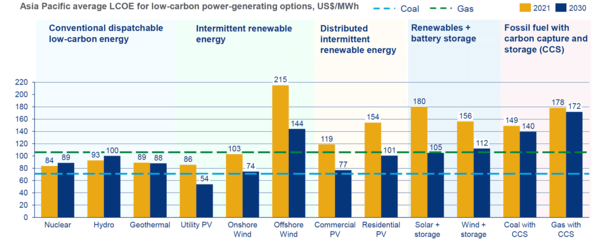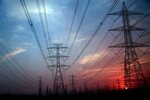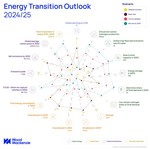News Release from Wood Mackenzie Ltd
Wind Industry Profile of
Renewable power in Asia Pacific gains competitiveness amidst cost inflation
Asia Pacific’s levelised cost of electricity (LCOE) for renewable power broke historical trends and rose in 2021 but still gained ground against fossil fuel power says Wood Mackenzie, a Verisk business (Nasdaq:VRSK).
Last year, Asia’s power crisis sent fossil fuels and renewable sources into a frenzy as prices spiked amidst strong demand and supply chain tightness. Spot market fuel prices averaged over the year pushed up costs of coal and gas power by 19% and 46% respectively, making renewables (utility PV and onshore wind) appear more competitive. However, increased equipment and logistics costs meant that solar and wind power were also hit by cost inflation.
Wood Mackenzie senior analyst Rishab Shrestha said: “The average LCOE across Asia Pacific for new solar projects increased by 9% to US$86 per megawatt-hour (MWh) and for onshore wind projects by 2% to US$103/MWh last year.
“Renewables’ supply chain bottlenecks are expected to ease in 2022 and beyond, and the respective LCOE will return to a declining trend.”
Currently, renewable power costs in Asia Pacific are about 16% more expensive on average compared to fossil fuel power costs over the project lifetime. India, China and Australia are the top three leaders with renewable power being between 12% and 29% cheaper than the lowest-cost fossil fuel, coal. Other major markets still have a significant renewables premium.
Shrestha added: “Interestingly, China is the only Asia Pacific market which has bucked the renewables premium cost inflation trend in 2021, supported by a mix of factors including rising fossil fuel prices, domestic manufacturing, zero-tolerance Covid policy, and its commitment towards climate change.”
Wood Mackenzie forecasts that by 2030, electricity from renewables (mostly utility PV) will be at a 28% discount to coal across the region. India, Australia and China remain low cost champions for renewable power with LCOE discounts ranging 50% - 55%. Both onshore wind and solar will be at a discount or at parity with gas and coal power in these markets. However, offshore wind LCOE in Asia Pacific will not be competitive against gas-fired power (CCGT) until the 2030s, except for China which will hit this milestone in the early 2020s.
Looking at other low carbon power technologies, Wood Mackenzie’s analysis reveals that nuclear, hydro and geothermal are among the cheapest low carbon dispatchable power options costing between US$84/MWh and US$93/MWh in 2021. This is already cheaper than gas-fired power, which remains flat at around US$105/MWh. These conventional technologies are likely to maintain a cost advantage of over 30% compared to carbon, capture and storage (CCS) and green fuel blending by 2050.

Image: Wood Mackenzie
Renewables integrated with battery storage has a 50% premium over gas power today but will be competitive by around 2030, becoming an increasing threat to gas power. CCS is expected to add 70% - 100% to generation costs and struggles to compete with firmed renewables and other low carbon options in the longer term.
Research director Alex Whitworth said: “Economics is a key factor in choosing options to reduce the fossil fuel share of the Asia Pacific power system, which sits at around 70% today. Although wind and solar costs are falling, options for reliable and dispatchable power to support decarbonisation are still very expensive.
“Take Japan for example, a fuel mix of 20% green or blue ammonia plus 80% coal as proposed, will cost around US$150/MWh even by 2030. This is more expensive than gas power while still emitting almost twice as much carbon. A combination of offshore wind and distributed solar backed up by storage and gas units would have a similar price tag. Is Japan ready for a potential doubling of the average power generation costs in 2030 compared to recent years?
“Japan is a very expensive market but across Asia Pacific there are similar challenges. A ‘firmed’ or dispatchable combination of low cost renewables, gas peakers and batteries costs around US$120/MWh today, about 60% higher than new coal power projects. It will take time to bridge the gap - the cost of this combination will fall to below US$70/MWh by 2050 and will become competitive with gas in the 2020s and coal in the 2030s.
“At the end of the day, economics is driving a higher share of wind and solar, but low cost intermittent renewables cannot replace fossil fuel power alone.”
- Source:
- Wood Mackenzie
- Author:
- Press Office
- Link:
- www.woodmac.com/...
- Keywords:
- Wood Mackenzie, Asia Pacfic, energy costs, price, risk, energy transition, energy crisis, power sector, renewable energy, Asia, trend, LCOE, onshore, offshore























